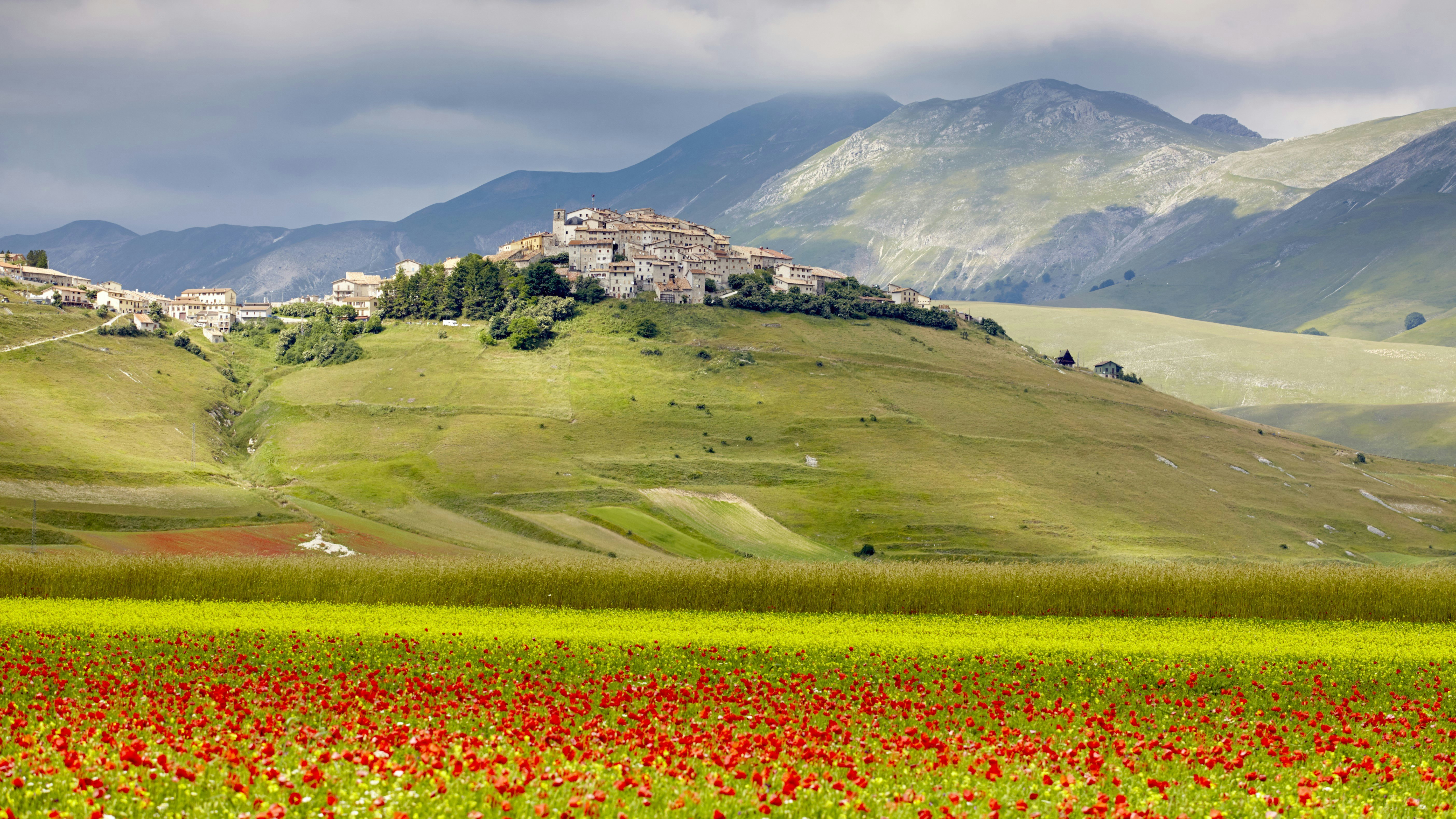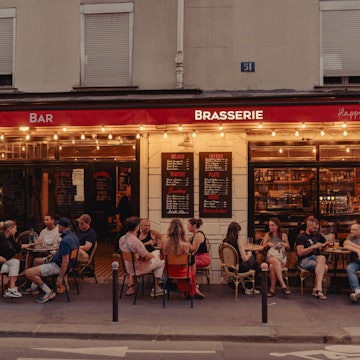

Find out the best time to visit Greece's beaches and other European treasures. Milos Momcilovic/Shutterstock
With weather as spectacularly diverse as its landscapes, cities and people, Europe is a terrific place to visit year-round. It can be snowing in one mountainous corner of the continent and sweltering hot in another, so it’s more about fine-tuning what you want from your trip than pinning down a single season. From flowery hikes through spring meadows to summer beach days and open-air festivals, to autumn vineyard rambles and gallery hops to Christmas market sparkle – Europe swings joyously with the seasons. There is never a bad time to come. And in terms of temperatures, it’s not just a simple case of north versus south; elevation is equally important to consider.
Deciding when to visit really depends on what you are looking for, but you’ll want to factor in your budget, the crowds, the activities you’ve planned, and the fact that the weather can, especially in northern climes, be fickle. Other than that, options are boundless and Europe really is your oyster.

Come in June for summer without the crowds
Competition is stiff, but June is among the best months to visit Europe. Days are getting longer and warmer, and the chances of rain dry up considerably across the continent, with temperatures hovering between 20°C to 30°C (68°F to 86°F) making June a cracking month for exploring and embracing outdoor activities. Whether you visit a city or the coast, you’ll be beating the biggest crowds in July and August. And as schools aren’t yet out for summer, there are deals to be had on flights and accommodation.
June also kicks off summer festival season, including biggies like the Karneval der Kulturen street parade in Berlin, the saintly, squeaky hammer-whacking shenanigans of the Festa de São João in Porto and Britain’s late-month Glastonbury Festival, with top-drawer gigs bringing around 200,000 revellers to muddy grounds to party like mad in their wellies. It’s a pretty month, too, with often clear skies and lots of blooms, most notably the painterly purple haze of lavender starting to streak the fields of Provence in France.
Find carnival fever across Europe in February
February can be chilly (or downright freezing) with temperatures ranging from -20°C (-4°F) in the Arctic to 15ºC (59°F) in the Med. Pre-Lenten feasting brightens the month with the glitz and glamour of flamboyant costumes as carnival season gets into full swing. Venice pulls out all the stops at Carnevale, with fancy masks, costumes, parties and parades in a riot of color. If you’re in Venice at this time, book that canalside B&B months ahead as the city gets rammed. Germany gets in on the act, too, with crazy parades and parties at Fasching or Fasnacht - especially in Bavaria and the Rhineland. One of the most famous celebrations takes Cologne by storm.

March to May is best for spring blooms
Europe bursts into life in spring – with flowers and blossom everywhere, making it a lovely season for hiking, cycling and garden hopping. Though you should bring waterproofs and an umbrella for the odd shower, temperatures are pleasantly mild, ranging on average between 10°C and 25°C (50°F to 77°F), depending how far north or south you go.
Come now for the flowers: vibrant tulips in bloom in the Netherlands – at their most outstanding in the Bollenstreek (Bulb Region) – bluebell-carpeted woods in Britain, poppies bringing a blaze of red to fields in Tuscany and cherry blossom falling in parks everywhere.
Easter brings bunnies, chocolate eggs, craft markets and a flurry of religious processions and passion plays to countries all over the continent, with top billing going to the likes of Semana Santa in Seville and Holy Week in Rome.
By May, things are warming up nicely and it’s a great, relatively quiet month for exploring the city or coast, with accommodation costs still comparatively low. Festivals are starting to get underway, with headliners like Seville’s Feria de Abril, a feast of flamenco and flamboyant horses, fado and revelry at Coimbra’s Queima das Fitas, and concerts on the Grand Place at Brussels Jazz Weekend late month.
July and August are for beach days and outdoor festivals
July and August are the hottest, busiest, most expensive months to visit Europe – especially if you have your sights set on mega-popular holiday destinations in the Med like Spain, the Greek Islands and Italy. Cities are often jam-packed now, too, so come prepared for queues and make sure you’ve booked everything well in advance. If you’re heading south, expect sizzling temperatures often topping 30°C (86°F) . Pack sunscreen and swimwear.
Beach bars, cafés, beer gardens and piazzas leap to life with a lively buzz. Many towns and resorts have a festive flavor, hosting events from open-air gigs to late-night markets while the festival scene goes through the roof. Don’t miss Siena’s Il Palio, bringing thundering horse hooves and bareback riders to a medieval hill town in Tuscany in July and August; France’s fervent Bastille Day celebrations on July 14, with fireworks, balls and parades; Austria’s Salzburg Festival, a five-week classical music and opera extravaganza; and Edinburgh International Festival, a mammoth celebration of the arts in the Scottish capital.
July and August are also peak season for long-distance hikes in the Alps, Pyrenees and Dolomites at elevations above 2000m (6561ft), with long days, snow-free trails, relatively stable weather and huts open (book your bunk well in advance).

September to October is for wine and leaf-peeping
Autumn can be a glorious season to visit Europe, with golden days, thinning crowds and shoulder-season prices sweetening the deal. With days still mild (from 15°C to 25°C, or 59°F to 77°F), September is ideal for outdoor activities like hiking, cycling and kayaking. It’s also the month when the wine harvest gets underway in vineyards all over Europe, bringing the swing of panniers, the musty scent of freshly crushed grapes on the breeze, color-changing foliage and new wine. Wine regions like the Loire Valley and Burgundy in France, the steeply terraced Douro in Portugal and the Montepulciano region in Tuscany, Italy, are at their radiant best.
September is great for festivals, too, with showstoppers like the star-studded Venice International Film Festival at the start of the month, and the stein-swinging, oompah band-fuelled excess of Oktoberfest in Munich rolling out the barrel at the end of it.
Nature puts on quite a show in fall, with rivers rising, migratory birds arriving and forests that are a rusty riot of gold and crimson, everywhere from the Scottish Highlands to Lake Bled in Slovenia’s Julian Alps, and Lombardy in Italy. In October, conditions become more unpredictable in the north, but edge south to destinations like Seville or the Canary islands, and you may still luck into some T-shirt and alfresco tapas weather.

November is best for coffee and culture
Properly off peak, November is one of the most quiet and inexpensive times to visit Europe. Resorts in the Med have closed for the season and the first flakes of snow fall on the highest peaks in the Alps. Generally, though, this is a chilly, blustery, rainy month, with temperatures averaging between 5°C and 15°C (41°F and 59°F), but don’t let that put you off. With waterproofs and woolly layers, this can be a brilliant time for snagging deals, skipping queues and exploring major cities such as Paris, Rome and Dubrovnik that are overcrowded the rest of the year.
And as the weather turns, the gaze shifts indoors to galleries, museums and cozy cafés. In fact, in cities like Vienna, Amsterdam and Copenhagen, an entire culture has been built up around slowing down, snuggling up and tuning into the hygge vibes of a café. Britain delivers a similar feel in country pubs with roaring fires, while skies light up with fireworks on November 5 for Bonfire Night, which commemorates the attempted assasination of King James I in 1605.

Northern lights shine from late September to early April
From autumn through spring, when skies are clear and solar storms are blowing, catch one of the greatest shows on earth around the Arctic Circle: the aurora borealis. When conditions are right, the northern lights flash from late September to early April. Solar activity is often highest in September and March, while the Polar Night (from November to mid-January), when the sun doesn’t rise above the horizon, also offers prime viewing.
Ramp up your chances by focusing on the Arctic and destinations positioned under the aurora oval, which forms a ring around the earth’s geomagnetic North Pole. Turn your gaze to the heavens in hotspots like Abisko in Sweden, Iceland's Westfjords, fjordside Tromsø and Svalbard in Norway, and Rovaniemi in Finnish Lapland. The more remote and dark the greater your changes are for seeing something truly magical. But remember, part of the lights’ allure is their brilliant unpredictability; and even if they are a no-show, the Arctic offers plenty of other splendor in winter, with a blizzard of activities from Santa and reindeer encounters to dogsledding, ice-fishing and snowshoeing.

December to March is best for festive fun and skiing
Christmas and New Year aside, this is overall a low-key, quiet, uncrowded time to visit Europe, and you should be able to bag good deals on flights and rooms. Weather can chop and change, dipping way below zero in Scandinavian and Alpine regions, and rising up to 15°C (59°F) in the south.
December brings twinkle in the form of Christmas markets sprinkling towns and cities all over Europe, with choirs, mulled wine, gingerbread and crafts. Some of the best and most traditional markets are in Germany, with the Christkindlmarkt in Nuremberg and Striezelmarkt in Dresden having the festive edge. Italian churches often set up an intricate crib or a presepe (nativity scene) for Natale.
Vienna’s ball season truly gets rolling in January and continues until Shrove Tuesday, with Strauss sending glamorously dressed folk waltzing across lavish ballrooms in the Austrian capital. Now is also the season to slip on skis as the flakes fall thick and fast at high elevations across the Alps, Pyrenees and Dolomites. Avoid the school holidays for more affordable deals.














